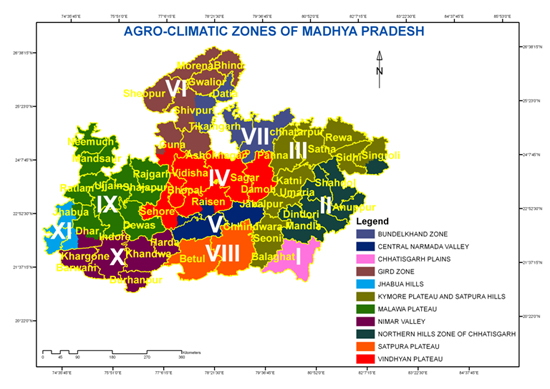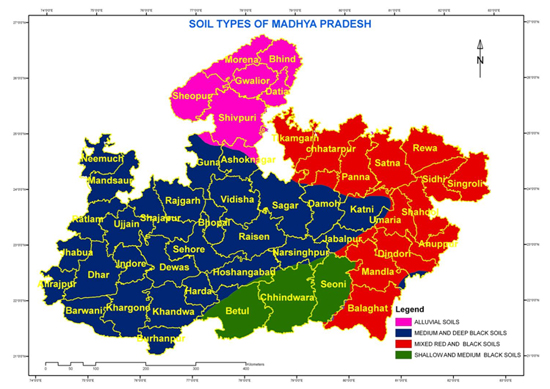Preamble
Government of India in coordination of the Govt. of Madhya Pradesh established the multi campus university at Jabalpur, in the heart of the country, named after the architect of modern India,Pt. Jawaharlal Nehru, based on the recommendations of Radhakrishnan Commission (1949) on the concept of establishment of Agricultural University. An approach was envisaged to narrow down the gap between the experts and farmers through Joint Indo-American Team on Agricultural Research and Education in 1954-55 and 1959-60 on the pattern of Land Grant Colleges of USA. College of Agriculture, Jabalpur was established in 1955 (affiliated to then Jabalpur University). On October 2, 1964, Jawaharlal Nehru Krishi Vishwa Vidyalaya (JNKVV) was inaugurated by the then Union Minister of Information and Broadcasting, Smt Indira Gandhi. Dr. J. S. Patel took over as the first Vice Chancellor in October 1964.
The Central Administrative Offices of the University are located about 7 km North of Jabalpur town on National Highway No. 7. The University had to part with the creation of sister universities Indira Gandhi Vishwa Vidyalaya (IGKVV) at Raipur in 1987, Rajmata Vijayaraje Scindia Krishi Vishwa Vidyalaya (RVSKVV), Gwalior in 2008 and Madhya Pradesh Pashu Chikitsa Vigyan Vishwa Vidyalaya, Jabalpur in 2009. At present, the University has four Agriculture, one Agricultural Engineering College, one Dryland Horticulture Research Station; five Zonal Agricultural Research Stations (ZARS), 5 Regional Agricultural Research Stations (RARS) and 20 Krishi Vigyan Kendras (KVK) spread over 25 districts.
With the establishment of the Faculty of Agriculture in Jawharlal Nehru Krshi Vishwa Vidyalaya, the Department of Soil Science & Agricultural Chemistry came into existence during 1967 which was first headed by Prof. P.M. Tamboli. However, M.Sc.(Ag.) & Ph.D. in Soil Science & Agril. Chemistry was started in 1962 and 1971, respectively. The Department runs M.Sc.(Ag) and Ph.D. degree programmes as scheduled by the VV. Soil Fertility and Plant Nutrition, Soil Physics, and Soil Microbiology are the prime areas of specialization in the department. The department has established several magnificent milestones in research, teaching and extension activities for the benefit to mankind, particularly to the farming community.
Mission
To conduct Education, Research and Extension activities for enhancing productivity, profitability and sustainability of agricultural production systems through maintaining soil fertility and productivity so as to improve quality of rural livelihood in the state of Madhya Pradesh
Mandate
- To conduct research and develop human resource in the field of Soil Science and Agricultural Chemistry.
- To disseminate technologies to farmers, extension functionaries and organizations engaged in agricultural development through various extension programmes.
Objectives
- To offer courses in different disciplines of Soil Science and Agricultural Chemistry for the undergraduate degree programmes in Agriculture, Horticulture, Agricultural Engineering and Forestry and Masters and Ph.D. degree programmes in Soil Science and Agricultural Chemistry.
- To exchange information with other scientists and extension staff engaged in similar pursuits through field trials, training, group discussion, symposia, seminar, conference and publications.
- To carry out the fundamental and applied researches on soils, especially in Pedology, Soil Classification, Soil physics, Soil Fertility, Soil Microbiology, Plant Nutrition, Agricultural Chemicals and Farm and Industrial Wastes Utilization
- Teaching: Under graduate and post graduate teaching, and trainings of scientists / teachers of ICAR SAUs and State Agril. Deptt. under Cnetre of Advanced Faculty Training (CAFT) and other programmes.
- Extension: Technology transfer and other activities
Agro-Climatic Characteristics
Out of 15 major agro-climatic zones of India (Planning Commission), three are spread over the Madhya Pradesh viz., Eastern plateau and hills region, Central plateau and hills region, and Western plateau and hills region. Further, the National Agriculture Research Project (NARP), based on rainfall, existing cropping pattern and administrative units, divided the whole country into 129 sub-zones (agro-climatic zones), out of which 12 sub-zones are of Madhya Pradesh State. The area under the University jurisdiction contains 7 agro-climatic zones viz., I. Chhattisgarh plains, III. Northern hills region of Chhattisgarh, IV. Kymore plateau and Satpura hills, V. Vindhyan plateau, VI. Central narmada valley, VIII. Bundelkhand zone, and IX. Satpura plateau.


Major soils of the country viz., Vertisols (high content of expansive clay, black cotton soils), Inceptisols (weakly developed soils due to rapid alteration parent materials, red and black soils), Entisols (little or no morphological / horizon developed soils of recent origin, river alluvium), and Alfisols (weathered / leached soils under deciduous forests, rich in Fe and Al) cover large tracts of the Madhya Pradesh State. These soils are highly diversified and are being cultivated primarily under rainfed conditions. Vertisols and associated soils are potentially productive but are faced with problems of drainage, tillage, excess moisture and drought stress. If managed properly, these may prove to be the grainaries of the country. The second biggest group of soils is of Alfisols which are inherently poor in fertility and moisture retention capacity. The third major group is of alluvial soils which have high percentage of irrigated farming and are faced with problems of salinity / alkalinity / water logging. Although deficiency of major nutrients, some of the soils are reported to be deficient in secondary and micronutrients, especially in S and Zn. Also wastelands, such as gullied and/or ravenous lands, degraded forest/plantation crops/pasture lands and mining industrial wastelands cover large tracts of the State
The overall climate varies from semi-arid to sub-humid with hot summer (38 to 44 oC), cool and dry winter (7 to 13 oC) with rainfall (during June to October) maximum 1200 to 1600 mm in Chhattisgarh plains and Northern hills region of Chhattisgarh, and minimum 1000 to 1500 mm in other agro-climatic zones; average crop growing period is 150 to 180 days; and forest type is tropical moist to tropical dry deciduous sal, teak, tendu, dhak/betua, anjan, etc. in Chhattisgarh plains, Vindhyan, Satpura and other hilly ranges; and semi-xerophytic vegetation, thorny, bushy type in northern and western parts). The main food crops are sorghum, wheat, rice and coarse grain such as kodo, little Italian millets. Important commercial crops are pulses, oilseeds, cotton, sugarcane and medicinal crops. The state is poised for a breakthrough in soybean cultivation. It is first in soybean, oilseeds, chickpea and maize production in the country. Kharif crops occupy 60% and rabi crops 40% area with 71.4% area under food grain production. Nearly 53% of landholders are marginal, whereas small farmers share 18% of farmland. Low literacy (35.45%), undulating topography, large waste land (13.2%), low ground water utilization, large proportion of rainfed agriculture (75%), practice of kharif fallow (3.6%), low cropping intensity (126%), low fertilizer consumption (31 kg/ha), high proportion of low value crops, and high population of low productive livestock are the major constraints of the state.